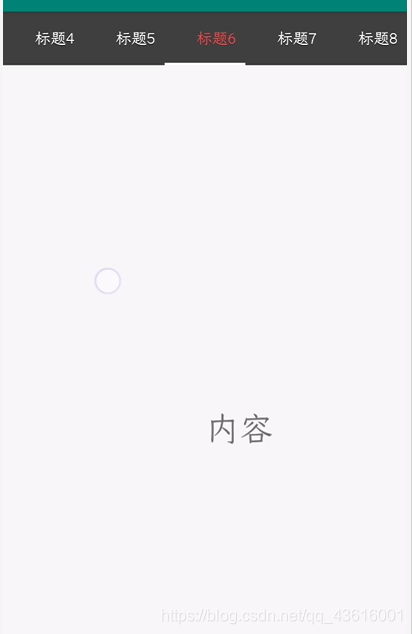首先需要依赖:implementation ‘com.android.support:design:28.0.0’
之后就是布局代码:
<LinearLayout xmlns:android="http://schemas.android.com/apk/res/android"
xmlns:app="http://schemas.android.com/apk/res-auto"
xmlns:tools="http://schemas.android.com/tools"
android:layout_width="match_parent"
android:layout_height="match_parent"
android:orientation="vertical"
tools:context=".MyTab">
<com.google.android.material.tabs.TabLayout
android:id="@+id/tl_main"
android:layout_width="match_parent"
android:layout_height="wrap_content"
android:background="@color/cardview_dark_background"
app:tabIndicatorColor="@android:color/white"
app:tabTextColor="@android:color/white"
app:tabSelectedTextColor="@android:color/holo_red_light"/>
<androidx.viewpager.widget.ViewPager
android:id="@+id/vp_main"
android:layout_width="match_parent"
android:layout_height="match_parent"/>
</LinearLayout>
上个app分别的意思是:1,选中时,下面横线颜色。2,字体默认颜色。3,选中时,字体的颜色
Main代码:
public class MyTab extends AppCompatActivity {
private List<MyFragment> list;
private ViewPager viewPager;
private MyFragmentAdapter adapter;
private TabLayout tabLayout;
@Override
protected void onCreate(Bundle savedInstanceState) {
super.onCreate(savedInstanceState);
setContentView(R.layout.activity_my_tab);
tabLayout=(TabLayout)findViewById(R.id.tl_main);
list=new ArrayList<>();
for(int i=0;i<15;i++){
list.add(new MyFragment("标题"+i));
}
viewPager=(ViewPager)findViewById(R.id.vp_main);
//第二个参数不知道什么作用,随便打的。第一个就是...跟着视频打的,第三个就是自己传过去的
adapter=new MyFragmentAdapter(getSupportFragmentManager(), 1,list);
viewPager.setAdapter(adapter);
//关联ViewPager
tabLayout.setupWithViewPager(viewPager);
//设置固定的标题列表
//tabLayout.setTabMode(TabLayout.MODE_FIXED);
//设置不固定的标题列表
tabLayout.setTabMode(TabLayout.MODE_SCROLLABLE);
}
}
设置Fragment视图:
public class MyFragment extends Fragment {
private String title;
public MyFragment(String title) {
this.title = title;
}
public String getTitle() {
return title;
}
@Nullable
@Override
public View onCreateView(@NonNull LayoutInflater inflater, @Nullable ViewGroup container, @Nullable Bundle savedInstanceState) {
return inflater.inflate(R.layout.fragment_one, container, false);
}
}
适配器:
public class MyFragmentAdapter extends FragmentPagerAdapter {
private List<MyFragment> list;
public MyFragmentAdapter(@NonNull FragmentManager fm, int behavior,List<MyFragment> list) {
super(fm, behavior);
this.list=list;
}
@NonNull
@Override
public Fragment getItem(int position) {
MyFragment fragment=list.get(position);
return fragment;
}
@Override
public int getCount() {
return list.size();
}
//得到标题
@Nullable
@Override
public CharSequence getPageTitle(int position) {
return list.get(position).getTitle();
}
}
效果图:

